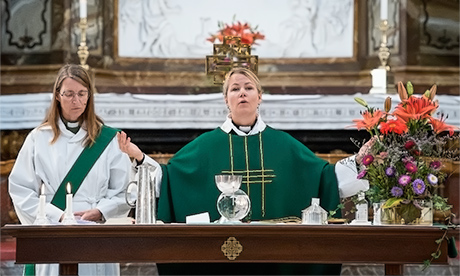Her white clergy robes flowing behind her, Sandra Signarsdotter walks down the aisle of Stockholm’s Gustaf Vasa church greeting parishioners, a ritual of hers and a familiar sight in Sweden, where women now outnumber men as priests.
In the Scandinavian country, often hailed as a champion of gender equality, the statistics are clear.
As of July, 50.1 per cent of priests are women and 49.9 per cent are men.
It’s very likely the first Church in the world to have a majority of women priests, according to the World Council of Churches.
In the Protestant Lutheran Church of Sweden, which has 5.8 million members in a country of 10.3 million and where ministers hold the title of priest, “women are here to stay,” insists Signarsdotter, who was ordained six years ago.
Since 2014, even the head of the Church is a woman, Archbishop Antje Jackelen.
At the Gustaf Vasa church, a smattering of worshippers wait for the service to begin.
“This Sunday, the service will be conducted by three women,” the 37-year-old priest says proudly.
Coincidentally, it was in this imposing white church in the heart of Sweden’s capital that another woman, Anna Howard Shaw, an American Methodist pastor and suffragette, became the first clergywoman to preach in Sweden.
That was in 1911, at an international women’s suffrage conference, and long before women could be ordained in the Church of Sweden, in 1958.
“The men didn’t allow her to go up there,” explains Signarsdotter, pointing to the marble pulpit above her.
“She was allowed only on the floor,” she says, standing at the altar as if to mark the spot.
This Sunday, the service will be held by Julia Svensson, a 23-year-old theology student whom Signarsdotter is mentoring — and she will give her sermon from the pulpit.
The feminisation of Sweden’s priesthood is also seen at universities, where the 4.5-year theology studies required to become a priest are dominated by women.
Protestants generally believe that a priest is an expert, a theologist who tends to a congregation, and not a calling, in contrast to the Catholic Church which opposes women priests.
The rising number of women may be due to priests’ changing roles over the years, suggests Signarsdotter.
“The priest’s role today is not what it was before. There are other requirements, (such as) kindliness … (and) being able to handle many different situations.”
“Historically men have held it for themselves but now we see it happening all over the world. Things are changing and new paths are open to us as female priests and women in general.”
Divine design
One who has benefitted from the rising number of female priests is stylist Maria Sjodin, who designs vestments for women and whose business is booming.
In her atelier in a southern Stockholm suburb, the designer recently welcomed a regular customer, a female priest looking for a new collared top.
One could say divine intervention landed Sjodin here: in 2001 her daughter made a new friend at kindergarten, whose mother was a priest.
“She asked me to make her a priest shirt, because she didn’t like the male shirt that she had to wear,” she recalled.
The piece remains one of the most popular in her collection. Continue reading
Additional readingNews category: Analysis and Comment.




